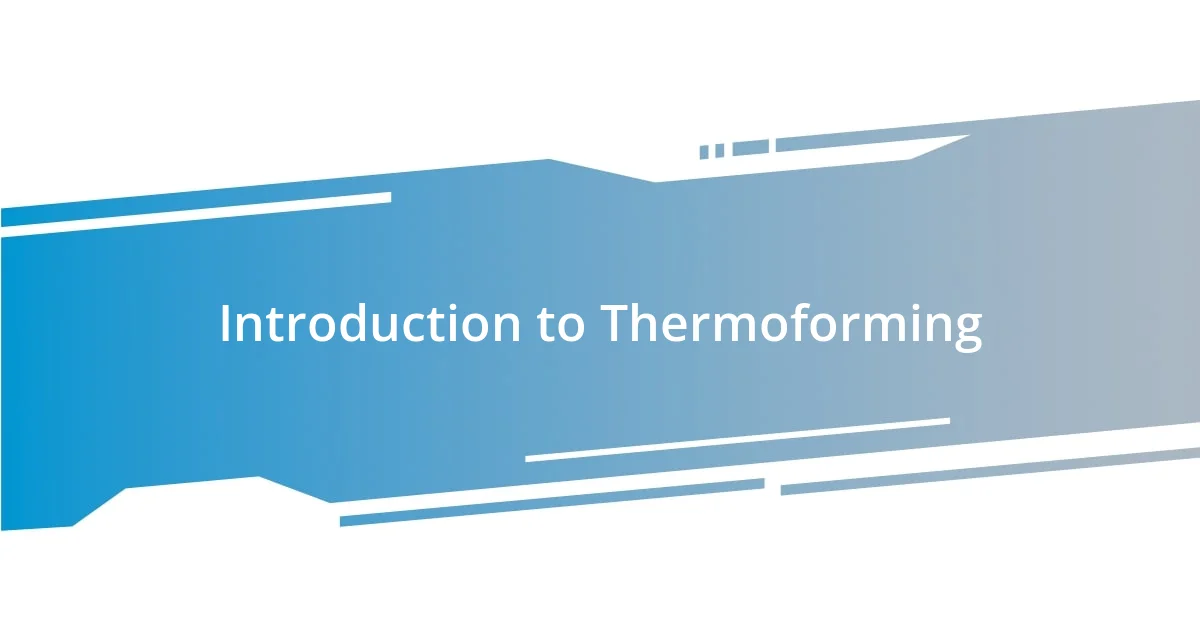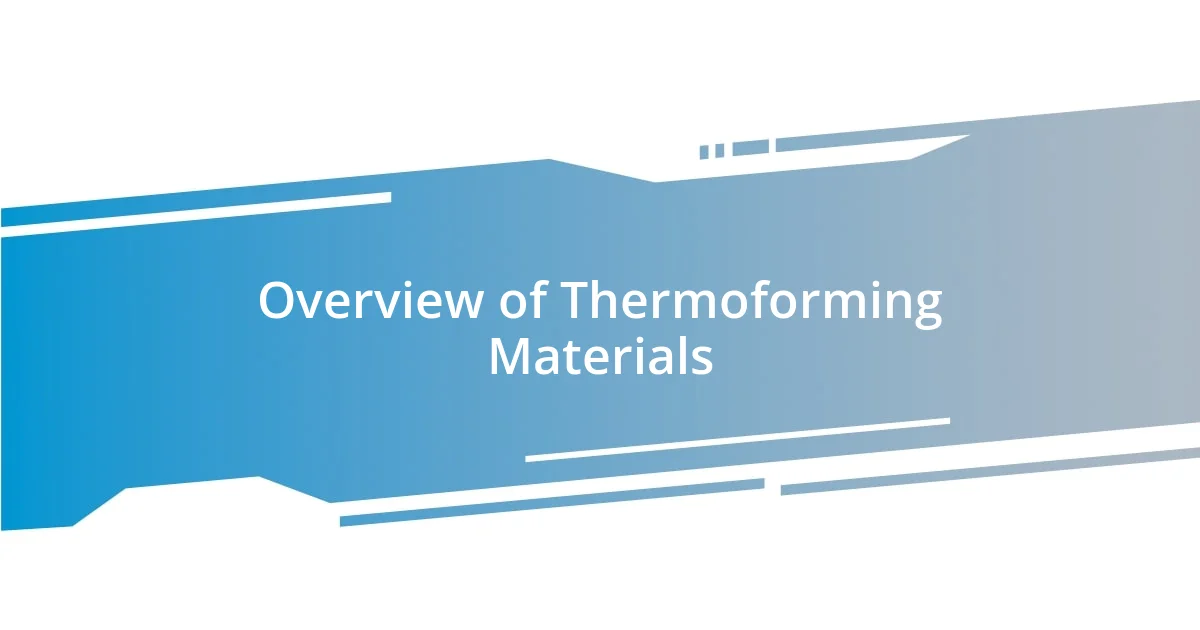Key takeaways:
- Thermoforming is a versatile manufacturing process that combines creativity with technical skill, requiring precision and patience for successful outcomes.
- The choice of materials significantly impacts the final product, with different plastics offering unique properties suitable for various applications, fostering a passion for sustainability.
- Common challenges in thermoforming include temperature control, material alignment, and maintaining vacuum levels, emphasizing the importance of careful experimentation and continual learning.

Introduction to Thermoforming
Thermoforming is a fascinating process that transforms heated plastic sheets into intricate shapes through the application of pressure and vacuum. I remember my first hands-on experience; watching a flat piece of plastic become a three-dimensional object felt almost magical. It made me realize just how versatile and powerful this technique can be in the world of manufacturing.
As I delved deeper into my thermoforming experiments, I often found myself asking, “What if?” This curiosity drove me to explore various materials and techniques, revealing the endless possibilities within this field. Each experiment taught me that the types of plastics used can dramatically influence the final product’s strength and flexibility, which was a revelation I hadn’t anticipated at the start of my journey.
It’s not just about the technical aspects; thermoforming is also a true art form. The delicate balance between heat and pressure can yield stunning results, but it demands precision and patience. I recall a project where I hurried through the setup, only to end up with warped shapes—a humbling reminder that this craft requires attention to detail and respect for the materials involved.

Overview of Thermoforming Materials
When it comes to thermoforming, the choice of materials can significantly affect the outcome of your project. During my experiments, I discovered that different plastics serve distinct purposes. For instance, ABS plastic offers a good balance of rigidity and impact resistance, making it ideal for applications like automotive parts. Meanwhile, materials such as PVC are more flexible, which can be excellent for creating custom packaging solutions. Each type unlocks unique possibilities and challenges, which I found both exciting and sometimes a little daunting.
I still remember the thrill I felt when experimenting with polycarbonate. Its exceptional clarity and strength opened up avenues for creative design I had never considered before. Initially, I was hesitant to work with it, fearing it might be too challenging, but the results were rewarding. I realized that pushing my boundaries with new materials not only enhanced my skills but also deepened my appreciation for the science at play within the process.
As I examined various thermoforming materials, I couldn’t help but reflect on how certain choices resonate on a personal level. For instance, using recyclable materials sparked a newfound passion for sustainability in my projects. It made me feel more connected to the responsibility we have towards the environment, encouraging me to share this knowledge with others. Thermoforming is not just about shaping materials; it’s a gateway to exploring innovation while remaining mindful of our planet.
| Material | Key Characteristics |
|---|---|
| ABS | Good impact resistance; rigid |
| PVC | Flexible; versatile for packaging |
| Polycarbonate | High clarity; strong and durable |
| HIPS | Lightweight; excellent for printing |
| PETG | Easy to thermoform; recyclable |

Key Techniques in Thermoforming
The key techniques in thermoforming I employed during my experiments showcased a mix of creativity and technical skill. For instance, the vacuum forming technique was particularly fascinating to me. This method allows the heated plastic sheet to conform to the mold flawlessly, creating an accurate and detailed product. I recall the excitement of unveiling my first vacuum-formed piece; it felt like flipping the final page of a gripping novel and discovering a satisfying conclusion.
Another technique that stood out was pressure forming, which I found especially rewarding. This method uses air pressure to push the plastic against the mold, resulting in complex shapes and superior detail. The first time I tried this technique, I was both anxious and exhilarated, but when I saw the crisp lines and contours emerge, I felt a rush of accomplishment. Here are some key techniques I learned through my experiments:
- Vacuum Forming: Utilizes a vacuum to pull the sheet against a mold, ensuring precise detail.
- Pressure Forming: Employs air pressure to shape materials into intricate designs.
- Mechanical Stretching: Involves stretching hot plastic over a mold through mechanical means for enhanced properties.
- Sequential Twin Sheet Forming: Combines two sheets to create hollow parts, perfect for lightweight designs.
Each method I experimented with opened up new doors in my understanding of thermoforming, transforming challenges into opportunities for growth and creativity.

Experiment Setup and Methodology
Setting up my thermoforming experiments required careful consideration of both equipment and materials. I remember spending hours researching the best type of vacuum forming machine to use. Ultimately, I settled on a model with adjustable temperature controls, which I found essential for achieving optimal results with various plastics. Isn’t it fascinating how a seemingly small detail, like precise temperature management, can drastically influence the outcome?
When it came to the methodology, I structured my experiments around a series of consistent steps. I prepped the material by cutting it into uniform sheets before heating it to the specified temperature. I vividly recall the moment I pulled the heated sheet over the mold for the first time; it was a bit like conducting an orchestra, with each element needing to perform in harmony. I focused on observing how the heating time influenced the material’s flexibility. This insight allowed me to refine my approach, tailoring my process to better suit each type of plastic.
Documentation was key throughout my experimentation. I kept a detailed journal, noting the variables I altered, such as temperature and forming speed, and their direct impact on the final product. Reflecting on this practice, I realized it wasn’t just about recording data; it became a vital part of my learning process. How could I expect to improve without a clear understanding of what worked and what didn’t? This systematic approach not only streamlined my workflow but also deepened my appreciation for the intricate nuances involved in thermoforming.

Analyzing Thermoforming Results
Analyzing the results of my thermoforming experiments revealed a treasure trove of insights. Take, for example, the various surface finishes I achieved. At first, I wasn’t fully aware of how critical the cooling process would be until I pulled a piece that had cooled too quickly, resulting in a warped structure. Seeing that flaw taught me the importance of patience in my workflow — sometimes, waiting can yield much better outcomes.
One experience stands out—when I finally mastered the balance between heating duration and mold cooling. After a series of attempts that produced underwhelming results, I decided to take a step back and reevaluate my observations. It was like piecing together a puzzle; I realized that even a slight variation in timing could create a world of difference. The moment I pulled that flawless, glossy product from the mold, I could hardly contain my excitement. Isn’t it fascinating how trial and error can lead to breakthroughs?
Each analysis brought valuable lessons, and I found myself more curious than ever about the science behind thermoforming. I began to document not just the successes, but also the misses, learning from each misstep. Reflecting on this, I recognize that the road to mastering any craft is often littered with imperfections. How else can we sharpen our skills and develop a deeper understanding if we don’t embrace those learning moments?

Common Challenges in Thermoforming
Common challenges in thermoforming often stem from the delicate balance between temperature, time, and material characteristics. I vividly recall an instance where I rushed through the heating phase, thinking I could save time. The result? A brittle product that shattered upon removal from the mold. It made me wonder: how much is speed worth if it compromises quality? I learned that patience is not merely a virtue but a necessity in thermoforming.
Another significant hurdle I faced was properly aligning the material with the mold. Early on, I underestimated the impact of precision and alignment, leading to uneven and misformed pieces. One time, I ended up with a beautiful mold, yet when I placed the plastic sheet on it, I realized it was a game of inches – a slight misalignment altered the entire shape. It was a frustrating reminder that even small oversights can lead to major setbacks. Have you ever felt that sinking feeling when you know a small detail could have saved you hours of rework?
Finally, maintaining consistent vacuum levels during the forming process proved to be a critical challenge. I remember adjusting and readjusting settings, only to pull a piece that was either too loose or had unsightly air pockets. It’s fascinating to think about how carefully calibrated processes can make or break a project. Reflecting on it, I wondered, how do professionals master such intricate details? I realized that understanding technology and ongoing adjustment is key, and it’s a journey of continual learning that I now embrace with open arms.

Practical Applications of Thermoforming
Thermoforming finds its way into various practical applications, each showcasing its versatility. For instance, during my experimentation with packaging materials, I noticed how effectively thermoformed designs can protect fragile items during shipping. The precision in creating custom containers left me astounded; it’s almost like sculpting a second skin for delicate products. Have you ever marveled at how much thought goes into the everyday packaging that surrounds us? It taught me that simplicity in design can often provide immense protection.
My journey with thermoforming also led me to explore the automotive industry. I remember molding parts for interior components, realizing that the right thermoformed materials can enhance both functionality and aesthetics. The seamless integration of forms like dashboards and panels made me appreciate how every contour serves a purpose. It’s remarkable to think that what may appear as a mere cosmetic choice has a substantial impact on user experiences. It prompted me to ponder: how often do we take these innovations for granted in our daily lives?
In the realm of medical devices, I experienced firsthand how thermoforming plays a pivotal role in creating tailored solutions. I vividly recall developing trays for surgical instruments, where the perfect fit is crucial for both safety and efficiency. Witnessing the way thermoforming enables customization to meet stringent health standards was enlightening. It made me realize the profound responsibility engineers have in ensuring these products uphold the highest quality. Have you considered how such techniques can fundamentally influence patient outcomes? It left me feeling grateful for the intricate processes that support our healthcare systems.
















